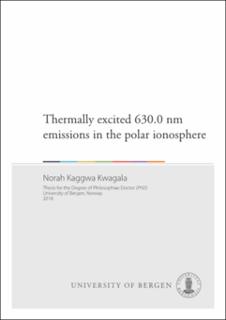Thermally excited 630.0 nm emissions in the polar ionosphere
Doctoral thesis
Permanent lenke
https://hdl.handle.net/1956/18714Utgivelsesdato
2018-08-24Metadata
Vis full innførselSamlinger
Sammendrag
This thesis investigates the importance and significance of thermally excited 630.0 nm emissions in the cusp and polar ionosphere. Thermal excitation by heated ambient electrons in the cusp and polar ionosphere is a rarely studied source of 630.0 nm emissions in this region, and is therefore, not well represented in literature. On the other hand, direct impact excitation by precipitating electrons and dissociative recombination have been extensively studied and they are believed to be the main sources of 630.0 nm emissions. This thesis utilizes ground-based incoherent scatter radar and optical measurements from Svalbard to study the thermally excited emissions. The thermal excitation component of the 630.0 nm emission is derived from EISCAT Svalbard Radar measurements. The thermal excitation component is then studied through both case and statistical studies presented in three scientific papers. The first part of this thesis investigates the contribution of the thermal component to the total observed 630.0 nm emission, and for the first time the thermal excitation component is separated from the observed total 630.0 nm emission intensity. The contribution is quantified and characteristics investigated. The second part of the thesis statistically investigates the occurrence of thermally excited emissions specifically focussing on the strong (intensity > 1 kR) thermal component. The magnetic local time distribution, emission intensity levels, ionosphere, solar wind and interplanetary magnetic field conditions, seasonal and solar cycle variations of the strong thermal excitation component are investigated. The main conclusions of this thesis are: → Thermal excitation can be important in the cusp and polar ionosphere, particularly on the dayside. It should therefore, be taken into account when studying dayside 630.0 nm emissions and electron thermal balance in this region. → The strong thermal excitation component maximizes around magnetic noon, with an occurrence rate of ∼10%. → When the strong thermal component is present, it can contribute >50% of the total 630.0 nm emission intensity. → The thermally excited emissions have a relatively high peak emission altitude of ∼350 km, and could be responsible for the 630.0 nm emission at such altitudes and above. → Thermal excitation is most likely to give rise to 630.0 nm emission intensities of order of kRs, when the electron gas temperature exceeds ∼2500 K for electron densities ∼(1-8)×1011 m−3. → Thermal excitation in the cusp and polar ionosphere maximizes during equinox and/or solar maximum. → Magnetic reconnection on the dayside is most likely the main driving process of the strong thermal excitation in the cusp and polar ionosphere.
Består av
Paper I: Kwagala NK, Oksavik K, Lorentzen DA, Johnsen MG. On the contribution of thermal excitation to the total 630.0 nm emissions in the northern cusp ionosphere. Journal of Geophysical Research - Space Physics. 2017;122:1234-1245. The article is available at: http://hdl.handle.net/1956/16667Paper II: Kwagala NK, Oksavik K, Lorentzen DA, Johnsen MG. How Often Do Thermally Excited 630.0 nm Emissions Occur in the Polar Ionosphere?. Journal of Geophysical Research - Space Physics. 2018;123:698-710. The article is available at: http://hdl.handle.net/1956/17447
Paper III: Kwagala NK, Oksavik K, Lorentzen DA, Johnsen MG, Laundal KM. Seasonal and Solar Cycle Variations of Thermally Excited 630.0 nm Emissions in the Polar Ionosphere. Journal of Geophysical Research - Space Physics. 2018;123(8):7029-7039. The article is available at: http://hdl.handle.net/1956/18713
